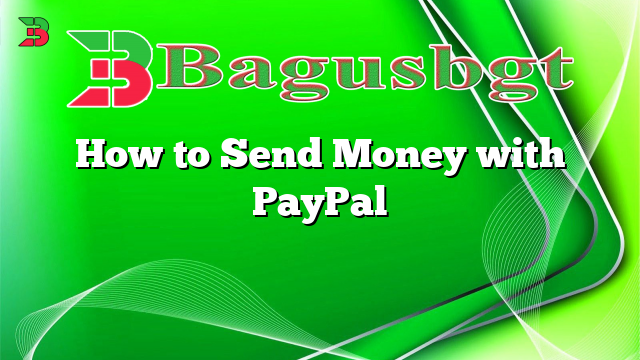Hello readers, welcome to this informative article on how to send money with PayPal. In this digital era, online transactions have become an essential part of our lives, and PayPal has emerged as one of the most popular and reliable platforms for sending and receiving money. In this article, we will guide you through the process of using PayPal and discuss its advantages and disadvantages.
Subtitles:
1. Creating a PayPal Account
The first step to sending money with PayPal is to create an account. Visit the PayPal website and click on the “Sign Up” button. Fill in your personal details, including your name, email address, and password. Make sure to use a strong and unique password for security purposes. Once you have provided all the necessary information, click on “Agree & Create Account.”
2. Linking Your Bank Account or Credit Card
After creating your PayPal account, you need to link it to your bank account or credit card. This step is crucial as it allows you to transfer funds from your bank account or use your credit card to make payments through PayPal. To link your bank account or credit card, go to the “Wallet” section in your PayPal account and follow the instructions provided.
3. Verifying Your PayPal Account
Verifying your PayPal account adds an extra layer of security and increases your transaction limit. To verify your account, PayPal will send a small amount of money to your linked bank account. Check your bank statement and enter the exact amount received on the PayPal website to complete the verification process.
4. Adding Recipients
Before sending money, you need to add the recipient’s information to your PayPal account. Click on the “Send & Request” tab and select “Send money to friends and family.” Enter the recipient’s email address or mobile number and click on “Next.” Make sure to double-check the information to avoid any errors.
5. Choosing the Payment Method
PayPal offers various payment methods, including your PayPal balance, linked bank account, or credit card. Select the preferred payment method for the transaction. If you have sufficient funds in your PayPal balance, it’s recommended to use it to avoid any additional fees.
6. Entering the Amount and Currency
Enter the amount you wish to send and select the appropriate currency. PayPal supports multiple currencies, making it convenient for international transactions. Ensure that you enter the correct amount and currency to avoid any discrepancies.
7. Reviewing and Confirming the Transaction
Take a moment to review all the details of your transaction, including the recipient’s information, payment method, amount, and currency. Once you have double-checked everything, click on the “Send” button to initiate the transaction. PayPal will provide a confirmation message once the transaction is successful.
8. Tracking Your Transactions
PayPal allows you to keep track of all your transactions for future reference. You can view your transaction history by clicking on the “Activity” tab in your PayPal account. This feature provides a comprehensive overview of your past transactions, including the date, time, recipient, and amount sent.
9. Advantages and Disadvantages of Using PayPal
Advantages:
- Convenience: PayPal offers a user-friendly interface, making it easy to send money with just a few clicks.
- Security: PayPal incorporates advanced security measures to protect your financial information and transactions.
- Widespread Acceptance: PayPal is accepted by numerous online merchants, making it a versatile payment option.
- International Transactions: PayPal supports multiple currencies, making it convenient for sending money across borders.
Disadvantages:
- Transaction Fees: PayPal charges fees for certain types of transactions, such as receiving payments for goods and services.
- Delayed Transfers: Transferring funds from your PayPal account to your bank account can take several business days.
- Potential Account Limitations: PayPal may limit your account access or freeze funds temporarily for security purposes.
10. Alternative Methods to Send Money
While PayPal is a popular choice, there are alternative methods available for sending money. Some notable options include:
- Bank Transfers: Directly transferring funds from your bank account to the recipient’s account.
- Mobile Payment Apps: Utilizing mobile payment apps such as Venmo, Google Pay, or Apple Pay.
- Money Transfer Services: Using services like Western Union or MoneyGram for international transfers.
PayPal Money Sending Guide:
| Steps | Description |
|---|---|
| 1 | Create a PayPal account |
| 2 | Link your bank account or credit card |
| 3 | Verify your PayPal account |
| 4 | Add recipients’ information |
| 5 | Choose the payment method |
| 6 | Enter the amount and currency |
| 7 | Review and confirm the transaction |
| 8 | Track your transactions |
Conclusion
Sending money with PayPal is a convenient and secure way to handle online transactions. By following the step-by-step guide provided in this article, you can easily navigate through the process of sending money with PayPal. Remember to consider the advantages and disadvantages of using PayPal and explore alternative methods if needed. Enjoy the seamless experience of sending money with PayPal!
FAQ
Q: Can I use PayPal without linking it to a bank account or credit card?
A: Yes, you can use PayPal to make payments or send money without linking it to a bank account or credit card. However, linking a funding source allows you to access additional features and benefits.
Q: Are there any transaction limits on PayPal?
A: Yes, PayPal imposes certain transaction limits depending on your account status and verification level. These limits can be raised by providing additional information and fulfilling specific requirements.
Q: Can I cancel a PayPal transaction?
A: PayPal allows you to cancel a transaction if the recipient has not claimed the funds. Go to the “Activity” tab, select the transaction, and click on “Cancel.” If the recipient has already claimed the funds, you can request a refund from the recipient directly.
 Bagus Banget Collection of the latest information from various reliable sources
Bagus Banget Collection of the latest information from various reliable sources





